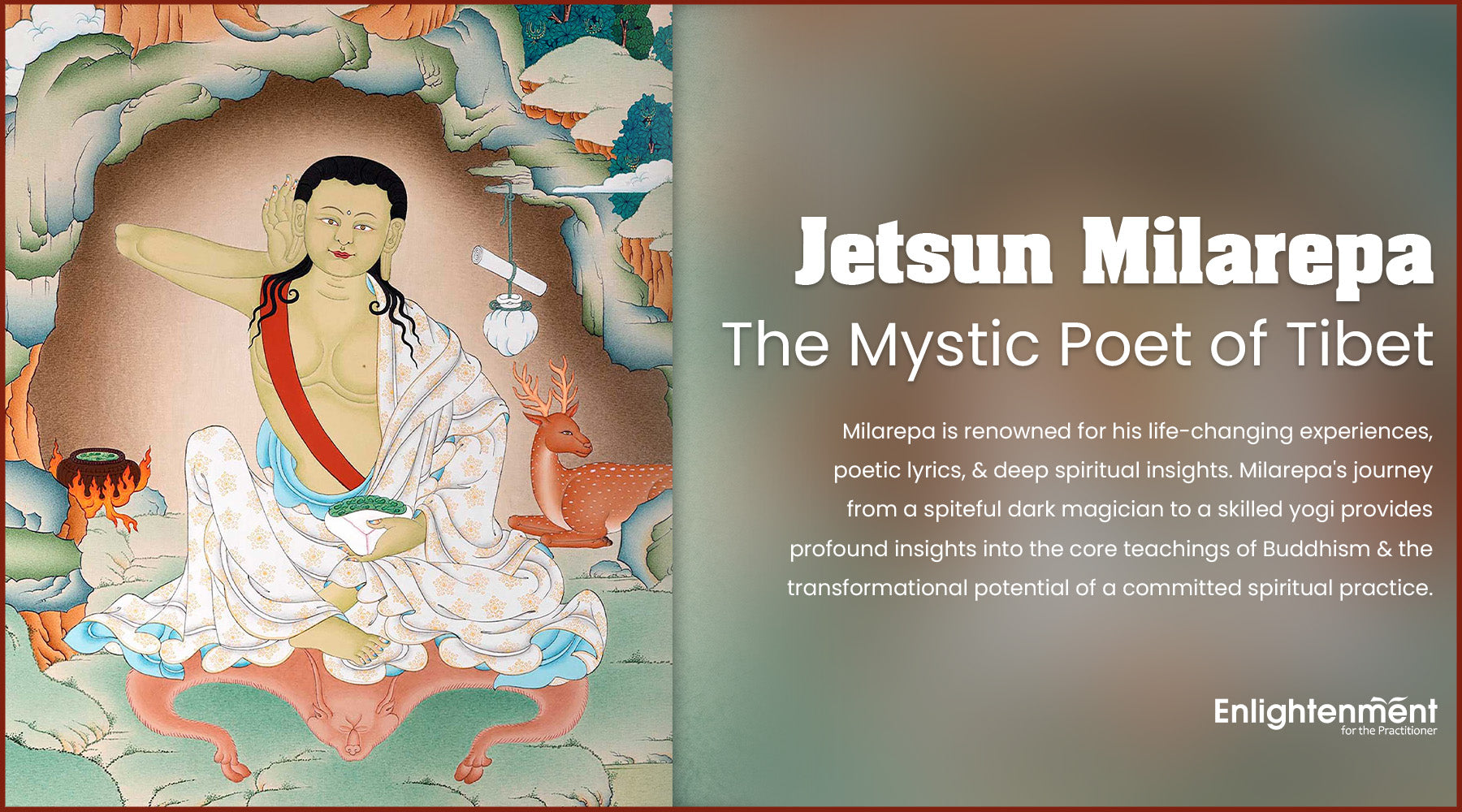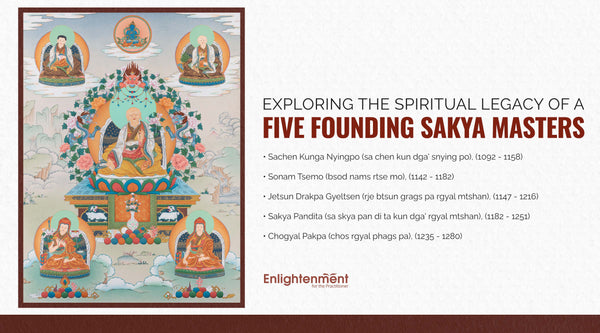Jetsun Milarepa: The Mystic Poet of Tibet
Jetsun Milarepa is renowned for his life-changing experiences, poetic lyrics, and deep spiritual insights. Milarepa's journey from a spiteful dark magician to a skilled yogi provides profound insights into the core teachings of Buddhism and the transformational potential of a committed spiritual practice.
Key Takeaways
- Milarepa is a central figure in Tibetan Buddhism, renowned for his spiritual poetry and profound teachings.
- His life is remarkably transformed from a vengeful black magician to a revered yogi.
- Milarepa's teachings emphasize renunciation, meditation, and the path to enlightenment.
- His songs and poems, encapsulating his spiritual journey, are celebrated in Tibetan culture.
The Life Of Milarepa
Click here to view our Milarepa Thangka
-
Birth and Heritage
Milarepa was born in the 11th century in Tibet. His early years were marked by familial wealth, which swiftly turned to misfortune upon his father's death.
-
Loss and Betrayal
Tragically, things took a fatal turn once Milarepa's father passed away too soon. Through dishonestly claiming the family's fortune, his relatives forced Milarepa and his mother into poverty.
Consumed by remorse, Milarepa redirected his path, dedicating his life to meditation and spiritual pursuits to cleanse his karma. This time frame played a significant role in molding Milarepa's early personality and later path.
The Path of Vengeance
-
Venturing into Black Magic
Milarepa resorted to black magic due to his mother's demands for vengeance and his desperation. He pursued a course that would bring him immense misery and bad luck by causing harm to people who had mistreated his family. -
Realization and Turning Point
After engaging in dark rituals, Milarepa quickly understood the terrible consequences of his deeds. Tormented by remorse and haunted by the results of his misdeeds, Milarepa's soul yearned for redemption.
He sought a way out of the abyss and turned to a spiritual path. This epiphany was crucial because it motivated him to pursue spiritual knowledge and atonement.
The Quest for Redemption: Seeking a Spiritual Guide
Unable to reconcile with the evil he had wrought, Milarepa disavowed his actions, committing the remainder of his life to a spiritual journey. Despite studying Buddhism, his guilt persisted, finding no solace until he encountered Marpa. Freshly returned from India, Marpa, a married lay Buddhist and translator, became Milarepa's guiding light, earning the title "root mentor" in his life. Seeing Milarepa's potential and troubled history, Marpa put him through rigorous tests to atone for his bad karma.
A Guru's Challenge & Testing Devotion: Marpa and Milarepa
Click here to view hand-painted Guru Marpha Thangka
Under Marpa's stern guidance, Milarepa endured a demanding regimen of physical labor. And mental discipline. Assigned the task of single-handedly constructing and Deconstructing a house, he tirelessly engaged in activities such as digging, Hauling, brick and wall construction, and roof assembly. This arduous process, devoid of explanation from the seemingly callous Marpa, it persisted for years.
Facing cold and exhaustion, Milarepa was also compelled to meditate relentlessly, with little respite. Marpa's seemingly harsh and whimsical directives pushed him to the brink of collapse and despair. Despite these challenges, Milarepa persisted, acknowledging the vastness of his past transgressions and feeling deserving of punishment. Over time, the influence of his tumultuous past on his mind diminished, yet he remained unaware of this transformation, devoid of pride or self-satisfaction.
Ascetic Life and Enlightenment
Under Marpa's direction, Milarepa followed a path of extreme asceticism. He withdrew into isolated caverns and devoted the rest of his life to spirituality and meditation. Enlightenment and significant spiritual realizations resulted from this time of seclusion and introspection.
| Aspect | Description |
| Spiritual Guide | Marpa, The Translator |
| Practices | Meditation, asceticism |
| Locations | Remote Himalayan caves |
| Achievements | Attainment of enlightenment, deep spiritual insights |
The Cave Retreat and Solitude
- Battles with Inner Demons and Temptations
Embarking on a solitary retreat in the mountains, Milarepa sought self-realization. Confronting inner demons, he battled temptations and grappled with the consequences of past wrongs, all while disconnected from the distractions of the world. His unwavering resolve in the face of these challenges brought him closer to enlightenment.
- Attaining Enlightenment
After years of unwavering devotion and intense reflection, Milarepa attained enlightenment. Through meditation techniques and profound contemplation, the realities of existence and the interconnectedness of all beings became clear to him. His newfound insight allowed him to transcend the cycles of suffering, grasp the essence of reality, and find inner peace.
Profound Teachings and Impact
-
Core Teachings of Milarepa
The main themes of Milarepa's teachings include renunciation, the value of meditation, and the quest for enlightenment. He highlighted the healing potential of inner spiritual activity and the freedom from mental illnesses. -
The Legacy of Milarepa's Songs
Especially well-known are Milarepa's impromptu songs of epiphany. These songs have been passed down through the years and have a particular position in Tibetan Buddhism. They are complete with spiritual knowledge. -
Influence on Tibetan Buddhism
Milarepa's life, teachings, and poetry have dramatically impacted Tibetan Buddhism, which has inspired many practitioners and shaped the region's spiritual legacy.
A central tenet of Milarepa's teachings is "non-dualism," asserting the interconnectedness of all things and the absence of division between self and other. This philosophy, emphasizing compassion and empathy, empowers practitioners to cultivate unconditional love and goodwill.
Tibet's Great Yogi and His Students :Gampopa
Click here to view our The Guru Disciple Statue Set
The most distinguished disciple of Milarepa played a pivotal role in the Kagyu Lineage. Four of Gampopa's students went on to establish the four primary branches of the Kagyu tradition: Barom Kagyu, Karma Kagyu, Phagdru Kagyu, and Tshalpa Kagyu. Another notable pupil of Milarepa, the yogi Rechungpa, Transmitted significant teachings into the Karma Kagyu lineage. Similar to Gampopa, Rechungpa served as a mentor to the first Karmapa Dusum Khyenpa (1110-1193).
In the later years, Milarepa dedicated himself to solitary meditation, relying on spontaneous songs of realization to guide and instruct groups of disciples known as "mgur."
The iconography of The Great Tibetan Yogi, Jetsun Milarepa
Milarepa, a highly revered yogi in Tibetan Buddhism is often depicted in various iconographic representations. Typically portrayed as a slender, slightly hunched figure and draped in a plain monk's robe, Milarepa is commonly depicted in a seated, cross-legged posture. In one hand, he holds a skullcup containing either a vajra or a nectar vase, symbolizing enlightenment.
The imagery of Milarepa often emphasizes his deep connection with nature, particularly evident in Thangka's paintings. Surrounded by Himalayan flora and fauna, including trees, peaks, and wild animals, these depictions underscore his profound belief in the interconnectedness of all things.
Milarepa's iconography frequently incorporates symbols like the lotus flower, the eight auspicious symbols, and various objects associated with Tibetan Buddhism, such as the bell and vajra. These elements underscore his role as a spiritual teacher and leader and position him within the broader context of the Tibetan Buddhist tradition.
Reflections and Relevance
-
Milarepa's Universal Message
The life tale of Milarepa offers timeless teachings about the transformative power of spiritual practice, transcending its historical setting. People looking to improve spiritually continue to find inspiration and resonance in his path from darkness to illumination.
-
Application in Modern Times
Milarepa's teachings on inner calm, simplicity, and mindfulness are more critical than ever in today's fast-paced world. They provide direction for achieving peace and meaning in the face of adversity.
How did Milarepa die?
At the age of 84, Milarepa passed away after ingesting poisoned curds, a malicious act orchestrated by the envious geshe Tsakpuwa (rtsag phu ba). Following his demise, Milarepa's students were left with scant possessions: a fragment of his robe, a lump of rock sugar, a knife, and flint steel. Allegedly, the bodily remains were claimed by clan goddesses during the burning of his body.
Milarepa's enduring legacy surpasses temporal and geographical boundaries. His life narrative, songs, and spiritual teachings have traversed generations, profoundly shaping the spiritual landscape. Even in contemporary times, his lessons in compassion, mindfulness, and self-realization continue to resonate, influencing seekers across the globe.


